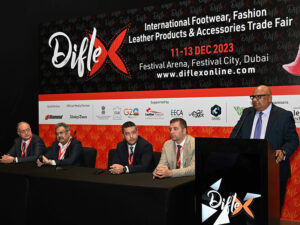Global leather focus on MENA to ride on an expected 6-8% retail spending surge
Footwear and leather goods exporters have assessed that the Middle East and North Africa (MENA) region offers a robust growth opportunity for the trade with retail spending power estimated to be surging in the range of 6-8 per cent CAGR across the region with the UAE and Saudi Arabia leading the trend.
Speaking at a press conference on the opening day of the region’s largest footwear and leather goods show, DIFLEX 2023, senior officials representing some of the global leather hubs – Egypt, India and Turkey, said the growth potential of MENA is amplified in the light of the data by Statista that non-food retail sales in the GCC alone is estimated to reach over US$ 150bn by 2026.
Significant demographic dividend
“MENA markets offer sunrise opportunities to leather producers and manufacturers with a rising population-5 per cent under the age of 30-offering a significant demographic dividend to both domestic and export businesses. Coupled with this is the increasing e-commerce spends and new fintech solutions like Buy Now Pay Later (BNPL) reshaping the consumer behaviour and making consumption and access to goods easier than before,” asserted Sanjay Leekha, Chairman, Council for Leather Exports, a Government of India statutory trade body under the Ministry of Commerce and Trade.

India, which is the second largest exporter of leather garments and fourth largest in leather goods globally had clocked US$ 5.2bn in 2022-23 fiscal. Over 60 top Indian footwear and leather goods manufacturers took part in the three-day DIFLEX 2023, 11 to 13 December at the Festival Arena in Dubai Festival City.
The CEPA effect
The UAE is a major driving force in enhancing trade with ramifications across the region with the country signing Comprehensive Economic Partnership Agreement (CEPA) with various countries enabling tariff-free access of goods including for footwear and leather goods.
“Being a major trading and re-export hub in the region, CEPAs catalyze trade in general and with concomitant value chain impact across MENA. For leather producers, this translates to ease of entry particularly in the wake of the rising trend of non-tariff trade barriers in western export destinations,” noted Leekha citing the new EU regulation on Forest Degradation Free supply chain that will add to the compliance costs of exporters.
“DIFLEX 2023 is a unique vantage point for growth for footwear and leather good exporters and as it is being held in a regional growth context, it is an opportunity to foster partnerships and forge new market entry strategies into MENA while e-commerce and consumer spending scaling new heights,” observed Jeen Joshua, Managing Director, Verifair, organisers of the event.
Over 250 top notch footwear, leather and leather accessories producers from across the world participated at this one-of-its-kind event, showcasing over 10,000 product lines. Manufacturers and Producers at DIFLEX were from the leading footwear and leather producing hubs of Turkey, Egypt, India, Sri Lanka, China and the UAE. Turkey, India and Egypt also have official country pavilions at the show.
